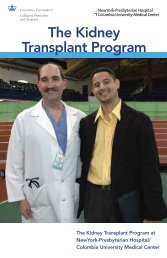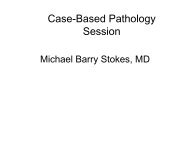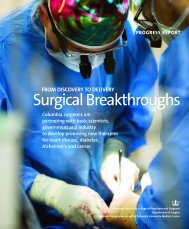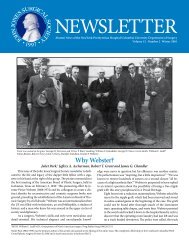Weight Loss for Life - Columbia Presbyterian Department of Surgery
Weight Loss for Life - Columbia Presbyterian Department of Surgery
Weight Loss for Life - Columbia Presbyterian Department of Surgery
You also want an ePaper? Increase the reach of your titles
YUMPU automatically turns print PDFs into web optimized ePapers that Google loves.
<strong>Weight</strong> <strong>Loss</strong><br />
<strong>for</strong> <strong>Life</strong><br />
New York-<strong>Presbyterian</strong><br />
Center <strong>for</strong> Obesity <strong>Surgery</strong><br />
at <strong>Columbia</strong> University Medical Center<br />
and Lawrence Hospital Center
<strong>Life</strong> enhancing,<br />
<strong>Life</strong> trans<strong>for</strong>ming,<br />
<strong>Life</strong> long.
A Message from the Director<br />
Welcome to the NewYork-<strong>Presbyterian</strong> Center <strong>for</strong><br />
Obesity <strong>Surgery</strong>. We understand what it means to<br />
constantly struggle with your weight, and we are<br />
pleased to <strong>of</strong>fer the opportunity <strong>for</strong> a long-term<br />
solution. Here at our center, we have helped many<br />
people achieve <strong>Weight</strong> <strong>Loss</strong> <strong>for</strong> <strong>Life</strong> through surgery, the<br />
only proven long-term treatment <strong>for</strong> severe obesity.<br />
In choosing to have surgery with us, you will<br />
benefit from a comprehensive program staffed by an<br />
expert team <strong>of</strong> Board-certified surgeons, advanced<br />
nurse practitioners, physician’s assistants, and<br />
registered dieticians at both the <strong>Columbia</strong> University and<br />
Lawrence Hospital Center sites. You will also benefit from our<br />
steadfast commitment to long-term personalized care.<br />
<strong>Weight</strong> <strong>Loss</strong> <strong>for</strong> <strong>Life</strong> is our program’s guiding principle—<br />
because surgery generally provides lifelong weight loss. In<br />
addition, people who are able to maintain an appropriate<br />
weight may enjoy longer life expectancy than those who are<br />
severely overweight. Most <strong>of</strong> our patients realize substantial<br />
weight loss soon after surgery, and experience a significant<br />
improvement in health and quality <strong>of</strong> life.<br />
<strong>Surgery</strong> is only one component <strong>of</strong> our program. Equally<br />
important is what comes be<strong>for</strong>e and after: our careful and<br />
thorough pre-operative evaluation and education, and the<br />
lifelong follow-up and support our team provides. Be<strong>for</strong>e our<br />
patients enter the operating room, they know exactly what to<br />
expect from surgery and what steps they will have to take<br />
afterward to maximize their weight loss success. As you take<br />
those first steps and settle into new routines and habits, you<br />
will have our full support. Whatever your questions or concerns—<br />
about particular foods or activities, or getting through<br />
a food-centered holiday or event, we are committed to being<br />
there with you every step <strong>of</strong> the way.<br />
One measure <strong>of</strong> our success is the community <strong>of</strong> patients<br />
that has grown out <strong>of</strong> our program. We have established<br />
1
<strong>for</strong>mal and in<strong>for</strong>mal ways to stay connected, from our<br />
newsletter and on-line support groups, to clothing exchange<br />
and monthly support meetings. A number <strong>of</strong> patients are<br />
happy to speak with you about weight loss surgery and their<br />
personal experiences.<br />
Choosing to undergo weight loss surgery is one <strong>of</strong> the<br />
most significant decisions you will ever make. For many, it is<br />
life trans<strong>for</strong>ming. For me, there is no greater satisfaction than<br />
to watch a patient emerge healthier, with an improved selfimage,<br />
and a newfound vitality <strong>for</strong> life. On behalf <strong>of</strong> our staff,<br />
I invite you to learn more about our program to help you<br />
decide if <strong>Weight</strong> <strong>Loss</strong> <strong>for</strong> <strong>Life</strong> is right <strong>for</strong> you.<br />
Sincerely,<br />
Marc Bessler, MD<br />
Director, NewYork-<strong>Presbyterian</strong> Center <strong>for</strong> Obesity <strong>Surgery</strong><br />
2
Criteria <strong>for</strong> <strong>Surgery</strong><br />
Who is<br />
a candidate<br />
<strong>for</strong> obesity<br />
surgery?<br />
Candidates <strong>for</strong> obesity surgery must meet the<br />
following criteria:<br />
•<br />
100 pounds or more overweight (body mass index—BMI—<strong>of</strong><br />
40 or above), or<br />
80 pounds or more over ideal body weight (BMI <strong>of</strong> 35 or<br />
•<br />
above), with related health problems such as diabetes, high<br />
blood pressure, or sleep apnea<br />
•<br />
•<br />
•<br />
Long-standing history <strong>of</strong> obesity (Many insurance companies<br />
require 5 years or more)<br />
Multiple weight loss attempts with no long-term success<br />
Ability to make the required lifelong dietary and behavioral<br />
changes as recommended by our weight loss team<br />
Body Mass Index (BMI) Chart<br />
3
Types <strong>of</strong> <strong>Surgery</strong><br />
Our center <strong>of</strong>fers a variety <strong>of</strong> laparoscopic and open weight<br />
loss procedures including gastric bypass (known as Roux-en-Y<br />
gastric bypass), adjustable gastric banding (LAP-BAND®), and<br />
biliopancreatic diversion with duodenal switch. Since these<br />
procedures assist in weight loss through different mechanisms,<br />
we will work with you in a comprehensive fashion to<br />
determine which procedure best fits your lifestyle and weight<br />
loss goals. Due to our expertise, we are also occasionally called<br />
upon to per<strong>for</strong>m revisional surgeries <strong>for</strong> patients.<br />
Please note graphics are simplified representations <strong>of</strong> the procedures.<br />
Normal Digestive System<br />
gallbladder<br />
esophagus<br />
stomach<br />
pancreas<br />
small<br />
bowel<br />
colon<br />
4
gallbladder<br />
Gastric Bypass<br />
esophagus<br />
Biliopancreatic Diversion<br />
with Duodenal Switch<br />
esophagus<br />
bypassed<br />
stomach<br />
reduced<br />
stomach<br />
bypassed<br />
small<br />
bowel<br />
food carrying<br />
(Roux-en-Y<br />
limb)<br />
(alimentary)<br />
food carrying<br />
limb<br />
intestinal<br />
re-attachment<br />
bypassed small bowel<br />
(biliopancreatic limb)<br />
colon<br />
common<br />
intestinal channel<br />
Adjustable Gastric Banding<br />
band tubing<br />
esophagus<br />
stomach pouch<br />
adjustable band<br />
adjustment<br />
port<br />
remainder <strong>of</strong><br />
stomach<br />
5
Gastric Bypass<br />
Roux-en-Y gastric bypass is the most common <strong>for</strong>m <strong>of</strong> weight<br />
loss surgery in the United States because it results in reliable<br />
weight loss with acceptable risks and side effects. In a<br />
standard gastric bypass, the surgeon divides the top <strong>of</strong> the<br />
stomach to create a small pouch, which functions as the new<br />
stomach. The surgeon then makes a small opening (stoma) in<br />
the pouch and attaches that opening to a limb <strong>of</strong> the small<br />
intestine, thus bypassing the majority <strong>of</strong> the stomach and a<br />
small portion <strong>of</strong> the intestine.<br />
Most people who meet criteria <strong>for</strong> surgery are candidates<br />
<strong>for</strong> laparoscopic gastric bypass, a minimal access approach<br />
that uses five to six small incisions in the abdomen, instead <strong>of</strong><br />
the six-to-eight-inch incision used in traditional “open” gastric<br />
bypass surgery. We are proud to have been among the<br />
pioneers in the use <strong>of</strong> laparoscopic gastric bypass in New York.<br />
Since the size <strong>of</strong> the new stomach pouch is limited, the<br />
patient quickly feels full. The altered digestive tract <strong>of</strong>ten<br />
reduces tolerance <strong>for</strong> fats and sweets, aiding patients in<br />
avoiding these foods.<br />
How Much<br />
<strong>Weight</strong> Can<br />
I Expect to<br />
Lose?<br />
What are the<br />
Dietary<br />
Restrictions<br />
and<br />
Requirements?<br />
The amount <strong>of</strong> weight lost with gastric bypass depends on<br />
many factors. Most lose 50 to 70 percent <strong>of</strong> their excess body<br />
weight within 12 to 18 months <strong>of</strong> surgery. Research has<br />
documented that 50 percent <strong>of</strong> excess weight loss lasts<br />
beyond 10 years, a testament to the long-lasting effects <strong>of</strong><br />
this procedure.<br />
You must maintain lifelong vitamin and mineral supplementation<br />
(with iron, calcium, Vitamin D, and Vitamin B12). You<br />
must also ensure that you maintain adequate protein intake.<br />
Finally, you should avoid excess fat and sugar. Our dietitian<br />
will provide detailed dietary requirements and strategies to<br />
help you adjust to new ways <strong>of</strong> eating. They will also keep you<br />
up-to-date on new nutrition findings, as part <strong>of</strong> our program<br />
<strong>of</strong> ongoing follow-up.<br />
6
Adjustable Gastric Banding<br />
Adjustable gastric banding, also known as LAP-BAND,® has<br />
been an established procedure since the early 1990s. It is one<br />
<strong>of</strong> the least invasive obesity surgery procedures, because<br />
neither the stomach nor the intestine is cut.<br />
In this procedure, the surgeon places an adjustable silastic<br />
band around the upper part <strong>of</strong> the stomach to create a new<br />
small pouch above the band. By adding fluid to the band after<br />
recovery from surgery, the surgeon adjusts the size <strong>of</strong> the<br />
opening between the smaller upper pouch and the remaining<br />
lower portion <strong>of</strong> the stomach. We work closely with each<br />
patient to make sure the band is properly adjusted and meets<br />
your specific needs.<br />
The tightness <strong>of</strong> the banded opening controls passage <strong>of</strong><br />
food between the two sections <strong>of</strong> the stomach and helps you<br />
feel full after eating. This full feeling lasts significantly longer<br />
than it would without the band.<br />
How Much<br />
<strong>Weight</strong> Can<br />
I Expect to<br />
Lose?<br />
What are the<br />
Dietary<br />
Restrictions<br />
and<br />
Requirements?<br />
<strong>Weight</strong> loss after adjustable gastric banding surgery tends to<br />
be more gradual than with gastric bypass. Most patients lose<br />
40 to 60 percent <strong>of</strong> their excess weight within two years <strong>of</strong><br />
having the operation. The amount you lose depends greatly<br />
on your commitment to new eating habits, exercise, and<br />
follow-up with our staff.<br />
You will need to plan your eating so that you have three meals<br />
a day, plus one or two planned snacks. As a nutritional<br />
supplement, you will also have to take a multivitamin. Food<br />
must be chewed thoroughly and swallowed slowly, and we<br />
advise you wait at least one hour between eating and drinking.<br />
Some patients find that they are unable to tolerate red<br />
meat, white rice, fresh bread, and fibrous foods following<br />
adjustable gastric banding. You must avoid sweets, snacking<br />
(except <strong>for</strong> the one or two planned snacks every day), and<br />
caloric beverages. It is also recommended that s<strong>of</strong>t foods (some<br />
cheeses, yogurts, and soups) be avoided because they will not<br />
stay in the pouch, and you will not feel full after eating them.<br />
7
Biliopancreatic Diversion with<br />
Duodenal Switch<br />
Biliopancreatic diversion with duodenal switch is a complex<br />
procedure that induces weight loss by combining mild<br />
restriction with significant malabsorption. With this<br />
procedure, the surgeon removes approximately 70 percent <strong>of</strong><br />
the stomach so that the stomach takes the shape <strong>of</strong> a<br />
tube. The distal small intestine is then divided much further<br />
downstream than with gastric bypass so that more intestine<br />
is bypassed and two intestinal pathways are created: one <strong>for</strong><br />
food, and one <strong>for</strong> the digestive enzymes, both <strong>of</strong> which meet<br />
to <strong>for</strong>m a common channel.<br />
Biliopancreatic diversion with duodenal switch preserves<br />
the pylorus (the outlet muscle that controls emptying <strong>of</strong> the<br />
stomach). It also <strong>of</strong>fers the ability to eat near normal portion<br />
sizes, and has reliable weight loss especially in the super<br />
obese. Since this operation induces a state <strong>of</strong> malabsorption,<br />
patients typically experience more frequent bowel<br />
movements and need to be monitored closely <strong>for</strong> vitamin and<br />
protein deficiencies.<br />
We are pleased to have Dr. William Inabnet on our staff,<br />
one <strong>of</strong> the physicians who helped pioneer the laparoscopic<br />
technique <strong>for</strong> biliopancreatic diversion with duodenal switch.<br />
How Much<br />
<strong>Weight</strong> Can<br />
I Expect to<br />
Lose?<br />
What are the<br />
Dietary<br />
Restrictions<br />
and<br />
Requirements?<br />
Most patients can expect to lose 60 to 80 percent <strong>of</strong> their<br />
excess body weight over a 2-year period. Clinical trials have<br />
demonstrated durable weight loss beyond 10 years.<br />
Patients may be able to eat a larger volume <strong>of</strong> food than with<br />
other procedures but should avoid large amounts <strong>of</strong> fat, sugar,<br />
and frequent snacking. Patients will need to take daily<br />
nutritional supplements <strong>for</strong> life including calcium, iron,<br />
multivitamin, and protein. In addition, since fat absorption is<br />
impaired, patients also need to supplement the fat soluble<br />
vitamins (vitamins A, D, E, and K).<br />
8
An Integrated Approach to<br />
<strong>Weight</strong> <strong>Loss</strong><br />
Be<strong>for</strong>e and after surgery, our surgeons, nurse practitioners,<br />
physician’s assistants, and registered dieticians, will be happy<br />
to talk to you about the many lifestyle changes and<br />
challenges you will face. We <strong>of</strong>fer support resources at every<br />
step <strong>of</strong> the process to assure your success, and we expect<br />
patients to stay in touch with us through regularly scheduled<br />
follow-up visits.<br />
We cannot overemphasize that surgery is only one part <strong>of</strong> our<br />
comprehensive weight loss program. Maintaining weight loss<br />
requires a lifelong commitment to good nutrition. You must<br />
adhere to dietary specifications, while taking vitamin and<br />
mineral supplements to ensure a proper balance <strong>of</strong> nutrients.<br />
Our registered dieticians will guide you and provide<br />
in<strong>for</strong>mation so that you understand all dietary requirements.<br />
A healthy lifestyle is important <strong>for</strong> ensuring long-term success<br />
following surgery. In addition to developing healthy eating<br />
habits, this will involve routine exercise and participating in<br />
activities that take the place <strong>of</strong> old eating habits. Our regularly<br />
scheduled group sessions and on-line bulletin boards provide<br />
support, updated in<strong>for</strong>mation, and healthful suggestions that<br />
will assist you in this process.<br />
9
Be<strong>for</strong>e and After<br />
“In one year I have lost about 140 pounds<br />
and have gained so much more than a scale<br />
could ever measure. I have a new body, a<br />
new outlook on life and a new confidence in<br />
myself. Medically, physically, emotionally<br />
and mentally, I am like a new woman! I<br />
cannot imagine having these kinds <strong>of</strong> results<br />
without the undying support and<br />
unsurpassed care I received, and continue to<br />
receive, at the NewYork-<strong>Presbyterian</strong> Center<br />
<strong>for</strong> Obesity <strong>Surgery</strong>. If you want the best <strong>for</strong><br />
yourself, you have to go to the best to get it.”<br />
IRINA<br />
“My Lap-Band experience has been one <strong>of</strong><br />
the best decisions <strong>of</strong> my life.”<br />
ERIC<br />
“Lap-Band surgery has given me back my<br />
life, and hope.”<br />
PATRICIA<br />
10
“My dreams <strong>for</strong> a better life started with the staff <strong>of</strong> the<br />
NewYork-<strong>Presbyterian</strong> Center <strong>for</strong> Obesity <strong>Surgery</strong>. I<br />
cannot say enough good things about them. They have<br />
helped me every step <strong>of</strong> the way. I’ve lost 125 pounds so<br />
far, and I am ready to start a new chapter in my life.<br />
My thanks and love to them all.”<br />
WILLIAM<br />
“Be<strong>for</strong>e my surgery I weighed 480 pounds. In two years<br />
I’m down to 285 pounds and I work out at the gym 5<br />
times a week. Instead <strong>of</strong> lying in bed with a bag <strong>of</strong> chips<br />
and dreaming <strong>of</strong> the life I always wanted, I am<br />
actually living it. My family and friends are so thrilled<br />
to see me actively participate in life again.”<br />
DAWNNE<br />
“I weighed nearly 400 pounds be<strong>for</strong>e the surgery and<br />
have lost over 160 pounds, and counting. When I have<br />
a bad day, I’ll call Dr. Bessler’s nutritionist, who will<br />
help me ride it out. Airplane seats aren’t uncom<strong>for</strong>table<br />
any more, and I am excited about my new muscles and<br />
taking kickboxing and karate classes.”<br />
LYNDA<br />
11
Directions<br />
The NewYork-<strong>Presbyterian</strong> Center <strong>for</strong> Obesity <strong>Surgery</strong> at<br />
<strong>Columbia</strong> University Medical Center<br />
161 Fort Washington Avenue, New York, NY 10032<br />
212.305.4000<br />
By Car: The most direct route to CUMC from most locations is<br />
to follow directions leading to the George Washington Bridge,<br />
then exit onto the Henry Hudson Parkway (also called the<br />
West Side Highway), and then onto Riverside Drive (south).<br />
From there, continue south and turn left onto 165th Street<br />
(the first left south <strong>of</strong> the bridge). Proceed one block and turn<br />
right onto Ft. Washington Avenue, then turn right into the<br />
Medical Center parking garage.<br />
Public Transportation within New York City: Take the A, C, #1,<br />
or #9 subway to 168th Street, or take the M2, M3, M4, M5, or<br />
M100 bus to CUMC. For additional bus and subway in<strong>for</strong>mation,<br />
call the Metropolitan Transit Authority at 718.330.1234.<br />
NewYork-<strong>Presbyterian</strong> Center <strong>for</strong> Obesity <strong>Surgery</strong><br />
at Lawrence Hospital Center. A member <strong>of</strong> the NewYork-<br />
<strong>Presbyterian</strong> Healthcare System and an affiliate <strong>of</strong><br />
<strong>Columbia</strong> University<br />
55 Palmer Avenue, Bronxville, NY 10708<br />
914.787.4000<br />
Lawrence Hospital Center is located in Bronxville, in Lower<br />
Westchester County. It is easily reached by car from all major<br />
routes in Westchester County. It is also reachable by three<br />
Westchester County Bee Line buses: Numbers 26, 30, and 52.<br />
For schedules call 914-682-2020 or check the Bee Line website<br />
at http://www.westchestergov.com. The Bronxville station <strong>of</strong><br />
the Metro North Railroad, Harlem Line services Bronxville is<br />
within easy walking distance <strong>of</strong> the hospital. For the schedule<br />
call 1-800-METRO-INFO or check the Metro North website at<br />
http://www.mta.nyc.ny.us.<br />
12
Visit us online<br />
www.obesitymd.org<br />
NewYork-<strong>Presbyterian</strong> Center <strong>for</strong> Obesity <strong>Surgery</strong><br />
at <strong>Columbia</strong> University Medical Center<br />
Herbert Irving Pavilion, Suite 620<br />
161 Fort Washington Avenue<br />
New York, NY 10032<br />
212.305.4000<br />
NewYork-<strong>Presbyterian</strong> Center <strong>for</strong> Obesity <strong>Surgery</strong><br />
at Lawrence Hospital Center.<br />
55 Palmer Avenue,<br />
Bronxville, NY 10708<br />
914.787.4000
















